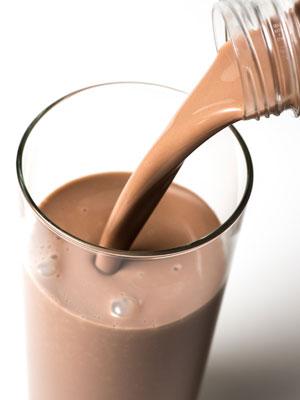Post-workout fueling: Got Chocolate Milk?

Fueling your body with the right nutrients within the first hour following strenuous activity is key to optimizing performance. During this time, blood flow to muscle tissue increases and muscles are sensitive to effects of a hormone called insulin, making them more likely to absorb glucose and replensih energy or glycogen stores. Additionally, muscle protein synthesis, or the rebuilding of muscle tissue, is maximized. Replenishing energy stores and maximizing muscle protein sythesis after each activity session will prepare you for the next bout of strenuous activity and help you achieve your performance goals.
Post-workout fueling can be simple and inexpensive. Your ideal nutrition choice after a workout only needs to include simpler forms of carbohydrates and a small amount of fast-digesting protein. It is not necessary to buy expensive dietary supplements that claim to accelerate recovery and build muscle. Most of these pricy choices are backed by claims and not science. Instead, try low-fat chocolate milk. Not only is it readily available and cost effective, it has clearly been shown to improve performance and recovery. Making this your No. 1 post-workout fueling option makes sense and here is why:
- Carbohydrate-to-protein ratio: Consuming simpler carbohydrates along with a small amount of fast-digesting protein, typically in a 3-1 or 4-1 ratio, optimizes recovery following a stenuous workout. Chocolate milk provides the ideal types and ratio of carbohydrates to protein to maximize recovery. An 8-ounce glass of chocolate milk provides approximately 30 grams of carbohydrates and 8 grams of protein. Its primary ingredients include glucose and lactose – simple carbohydrates – and whey, an easily digested protein. Choose low-fat or nonfat varieties to minimize fat intake, which can slow down digestion and delay the recovery process.
- Hydration: Milk, suprisingly, is an ideal choice to help replenish fluids and rehydrate following a workout. The naturally occuring protein and sodium found in milk has been shown to improve fluid retention, which can lead to faster and improved rehydration following exercise.
- Convenience: Time constraints and availability often deter people from fueling after a workout. Chocolate milk is pre-mixed and comes in many convenient sizes and containers, making it easily portable and ready-to-drink. Place a container in a small cooler with an ice pack and put it in your car or gym bag before heading to the gym or practice. Don't have time to grab some chocolate milk before leaving the house? Go to any gas station, cafeteria, grocery store or even certain vending machines and you are likely to find low-fat chocolate milk.
- Cost: Chocolate milk only costs about 25 to 50 cents per 8-ounce serving. Skip the pricy protein powders, shots, nutrition bars and pre-made postworkout shakes. Many of these options are considered dietary supplements, which can be risky choices since they are not regulated by the FDA. Additionally, many nutrition bars are expensive candy bars in disguise – they are typically high in fat and do not contain the ideal ratio of carbohydrates-to-protein.
- Taste: Sometimes the idea of eating after a hard workout is not appealing, and often people have a hard time tolerating solid foods. Fluids, however, tend to be more appealing, especially if you are trying to cool down, and studies have found that chocolate milk was ranked high for tastiness and tolerance among trained athletes.
Still not convinced? Try the chocolate milk challenge. Drink 8 ounces of chocolate milk within 60 minutes after each exercise session for one week and see how you feel. Were you a little less sore? Did you have more energy the rest of the day after your workout and also during your next workout session?
Lastly, don't let an intolerance for milk and other dairy products deter you from optimizing your recovery. Try low-fat chocolate soymilk instead. Similar to diary milk, chocolate soymilk provides the ideal ratio of carbohydrates-to-protein, aides in hydration, and contains the simple carbohydrates and easily digested protein needed to facilitate a faster recovery.
